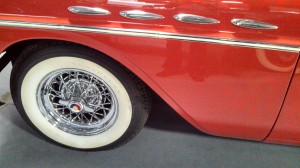 Well let’s face it. Summer just can’t last forever. It’s polar vortex season. Where did I put that long underwear? I have to say that early on in my car career I ignored my car before winter hit. I remember a ski trip to Idaho in my college years (I am not telling how long ago that was) where my car actually froze solid. I left my car outside a ski resort for four days. The temperature was way below freezing. When it was time to go I got in my car and sat on frozen seats that were as hard as a rock. I put the key in and the car wouldn’t start. It didn’t even make a noise when I turned the key. It was a harsh lesson to learn that I needed to check my anti-freeze and battery before winter hit. I still remember the hotel crew that put a pan of burning coals under my engine to get it unfrozen. That along with a jump start got me going. I was extremely lucky. Who would have thought?
Well let’s face it. Summer just can’t last forever. It’s polar vortex season. Where did I put that long underwear? I have to say that early on in my car career I ignored my car before winter hit. I remember a ski trip to Idaho in my college years (I am not telling how long ago that was) where my car actually froze solid. I left my car outside a ski resort for four days. The temperature was way below freezing. When it was time to go I got in my car and sat on frozen seats that were as hard as a rock. I put the key in and the car wouldn’t start. It didn’t even make a noise when I turned the key. It was a harsh lesson to learn that I needed to check my anti-freeze and battery before winter hit. I still remember the hotel crew that put a pan of burning coals under my engine to get it unfrozen. That along with a jump start got me going. I was extremely lucky. Who would have thought?
With this winter theme I want to share the steps I take to winterize my car and get ready for frigid weather. I will cover the steps to take to make sure your car does not freeze up like an ice cube and just won’t run.
Where do you Start in Winterizing Your Car?
The first thing I do to winterize my car is to check the engines anti-freeze (also commonly and confusingly called coolant). With the engine cooled off I open the radiator cap and check the color of the coolant. Most cars use a formula that is bright green. If it looks brown it is a good sigh that it is shot. Some cars use a formula that is red but if it looks dark and cloudy it is still a good indicator that it needs to be replaced.
I used to drain and add coolant right in my own driveway. Today, we need to be a lot more environmentally green. Don’t drain it out all over the ground. The last thing you want is to let that mess get into the storm drain. I recommend taking your car into a trusted repair shop and having it done there.
Have old coolant replaced. In some cases your mechanic will suggest that the radiator be flushed out. If your car is a little older and you don’t remember ever having this done I would say go for it. This service is a whole lot cheaper than dealing with an engine that has been damaged by the cold.
While the coolant is being replaced ask your mechanic to inspect the radiator and heater hoses as well. If your hoses are soft or cracked this is the time to do some preventative maintenance. One other thing, I have asked my mechanics to run a pressure test on my radiator and cooling system to check for leaks. Just do it!
Another important thing to check is your windshield washer fluid level. I don’t know about you but when big dirty trucks pass me on a rainy or snowy day I can’t stand trying to look through the wet mess they splatter up onto the windshield. You need to see clearly to drive safely. Read the label on the cleaner you choose – make sure it has a non-freezing formula.
I also give my poor hard working tires a little love this time of year. It is a good idea to check your tires air pressure. Properly inflated tires help maintain traction and tire life. Check your owner’s manual for the proper air pressure. You can always swing into one of the national chain tire stores and they will check if for you.
Winter is time to think traction. You have some options here. You can start off with a good all-season tire. These are designed for all weather conditions. If you live in a part of the country that gets heavy snow you may want to shop for some snow tires. Also, you can give some thought to some studded tires. There is some debate going around as to which is best – studded or non-studded winter tires. I have gotten around just fine with my all-seasons…but I live in seattle, the land of rain showers. It is pretty rare for us to get buried by snow. If we do I take a snow day and work on my website just a little more.
Also, you might want to think about getting a set of tire chains. There are times when they are required – especially travelling over mountain passes. They can be pretty handy when those neighborhood roads are almost undriveable too.
The next thing I do when winter hits is to check out my battery. Start with a visual inspection. Look at the in service date stamp. Most common batteries come in 20 to 36 month lives (there are some that last quite a bit longer out there). Now check the condition of the battery terminals. There should be no corrosion on them. If there is you can disconnect the battery cables and clean it off with some baking soda mixed with water (wear protective gloves and safety glasses or goggles). The last thing to do is to have the battery load tested by a mechanic. You want that car to start when it is freezing outside.
The final thing that I do this time of year is to put together a winter emergency kit. If you are traveling in a winter wonderland there are some things you should carry:
- Extra food and water
- Extra warm clothes and a pair of waterproof boots
- Snow shovel
- Window scraper
- Blanket
- Jumper cables
- A can of tire inflator
- Tire chains
- Flashlight and spare batteries
- First aid kit
- Warm waterproof gloves
- Emergency radio – with an extra battery
You can add to this list but this is my minimum winter kit. One last thing in this vein, make sure you bring a car charger for your cell phone. You never know if you will get stuck on some mountain pass and need assistance.
Well there you have it. There are some basic things to do to get ready for winter weather. Check that engine anti-freeze, Inspect your hoses and radiator, make sure your windshield washer fluid is full, check your tires air pressure, consider what you need for winter traction, check out the battery and put together an emergency winter driving kit. I don’t know about you but I hate being stuck on the side of the road without some supplies. I remember a winter trip over the pass from Seattle to Spokane. The road was covered in a thick sheet of ice. Traffic was at a standstill for two hours while some snow plows cleared the road a few miles ahead. That spare food I packed came in pretty handy. So did the blanket – you can’t idle away all your gas trying to keep the heater running.
Don’t let the elements keep you from getting around. However, respect the conditions of the road and keep an eye on the weather forecast. As they always say, if you don’t need to go out for something important just stay home and keep warm.


